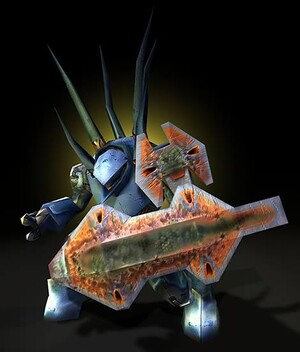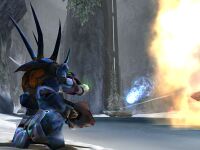Lekgolo
From Halopedia, the Halo wiki
The Covenant Hunters, or Lekgolo by their own name, are more like living tanks than anything else.
Hunters stand 12' tall, though in their combat state they crouch to approximately eight feet. Hunters fight with Fuel Rod Guns (there are two different types in Halo 1 and Halo 2) integrated directly into their armor. They carry an enormous and nearly-impervious metal shield made of an unknown alloy and as thick as the armor plating on Covenant Starships, which they sometimes use as a melee weapon. In Halo 2, the modifications to their Fuel Rod Cannon are similar to the modifications Cortana made to Ascendant Justice's weapons. The fire is more sustained, and more devastating.
Culture
Hunters almost never associate (or indeed even communicate) with other Covenant client races, save for the Elites. They are dismissive, scornful, and arrogant to the "lesser" Covenant races, and are utterly contemptuous of their foes. Hunters were forced into the Covenant by the superior starship technology of the Elites - on the ground they were almost, if not always, victorious. Faced with extinction by orbital bombardment, they joined the Covenant.
Hunters have three names: personal name, bond name, and line name. The personal name is given at birth. The line name represents the genetic heritage, being the name of the most successful Hunter of his ancestors. If a Hunter reaches a certain level of status, his offspring will have his personal name as their line name. The bond name is taken between bonded pairs, a relationship about which little is known, but it appears to be something like a lifelong partner. Bonded Hunters consider themselves brothers and are fiercely protective of each other. Examples of Hunter names include Igido Nosa Hurru, and Ogada Nosa Fasu.
Hunters are a warlike species, though are known to recite poetry according to Ghosts of Onyx
Hunters are nearly never seen alone, and are very dangerous as they work in pairs. They are also known to make a movement very similar to dancing when they cannot get into a space.
During the Covenant Civil War, the Hunters sided with the Elite Separatists. No reason is known yet but it is likely due to their deep respect for the Elites.
Frank O'Connor has said: "Hunter society is complex and we have seen but the tiniest fraction of it. There are some fundamental facts about Hunter biology that mean the combat type is just the tip of the iceberg."[1]
Physiology
The Hunter is speculated to not be a singular organism, but rather a hive creature composed of multiple small, orange, worm-like organisms (called Lekgolo eels by fans) that form a singular collective conciousness and act as one. Their armor has the dual purpose of both protecting them and maintaining body shape. The books contradict this, however, for they are described as "brothers" and that they have "bonds". Niether of these theories have been confirmed by Bungie themselves.
Hunters have very sharp, long spines, and are covered in metal armor. Hunters have been known to impale careless Marines upon these spines when surrounded.
Hunter's mostly make growls during battle but will sometimes talk and make remarks like the other Covenant species do as well. Instead of using vocal chords, they vibrate their bodies to make a low rumble that is described to be "more felt than heard" to produce speech. It is perhaps their own language.
It is theorized that Hunters reproduce asexually.
Being a collective mind might have the advantage of being immune from the Flood, no infected Hunter has ever been encountered so far.
Combat
The easiest way to kill a Hunter is to shoot the uncovered orange parts of its body on its neck, abdomen, sides, and back. It is also possible to melee attack this spot for the same effect, though it it much harder and takes more attacks. It is left open, however, when it tries to melee attack you. It then staggers for a short while, leaving you a short window of time to turn around and shoot its back. A powerful, high velocity round (from a pistol or sniper rifle) fired into one of these exposed areas will kill the Hunter instantly. An alternate way to reach the weak orange spots in Halo: combat evolved is to go up to a hunter and walk in a very tight circle around it to reach the back. If this tactic is done correctly you can move faster than the hunter can spin and you shouldn't be in front of the hunter; thus avoiding any attempted melee attacks and you can get a direct hit while the hunter is still trying to face you.
If you stand far away from the Hunter it will use its fuel rod cannon in an attempt to kill you, however the shot is slow, and easily dodged. If you are in melee range of the Hunter it may use its shield to bash you, resulting in heavy damage, if not death. If you stand behind the Hunter it will lift its shield into the air, then swing it back at you in an attempt to crush you. All of these moves are fairly easy to dodge but will result in a devastating blow to your health if you are hit.
Grenades aren't very effective against Hunters, and it will usually take a large amount of them to take one down. However, grenades, at least the plasma variety, will disorient or stun them, which may cause a charging Hunter to change directions, during which time you can easily shoot at their exposed flesh.
In Halo 2, you first encounter Hunters on the level Outskirts. When you first encounter the Hunters, it is easy to use the machine gun on the second floor of the building, but this becomes harder on Heroic and Legendary difficulties, as the gun is very exposed and one shot from the Hunters' fuel rod guns and it will be destroyed. Another way to deal with the Hunters is to take the sniper rifle from Sergeant Johnson, and shoot the exposed flesh on their back or when they raise their shield.
Trivia
- "Lekgolo" is Tswana for "one hundred".
- Hunters were first seen by humans in 2552 in The Battle of Sigma Octanus IV.
- Hunters in Halo 2 are significantly larger than those in Halo: Combat Evolved and are harder to kill.
Related Links
Internal


